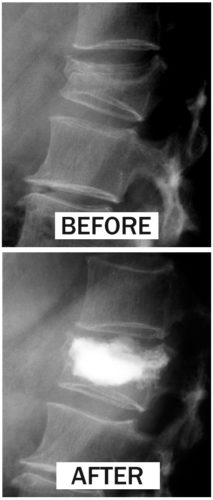What are Vertebroplasty and Kyphoplasty?
Vertebroplasty and kyphoplasty are minimally invasive procedures for the treatment of painful vertebral compression fractures (VCF), which are fractures involving the vertebral bodies that make up the spinal column.
When a vertebral body fractures, the usual rectangular shape of the bone becomes compressed, causing pain. These compression fractures may involve the collapse of one or more vertebrae in the spine and are a common result of osteoporosis.
Osteoporosis is a disease that results in a loss of normal bone density, mass and strength, leading to a condition in which bones become increasingly porous, and vulnerable to breaking easily. Vertebrae may also become weakened by cancer.
For a vertebroplasty, physicians use image guidance, typically fluoroscopy, to inject a cement mixture into the fractured bone through a hollow needle.
During kyphoplasty, a balloon is first inserted into the fractured bone through the hollow needle to create a cavity or space. The cement is injected into the cavity once the balloon is removed.

Benefits
- Vertebroplasty and kyphoplasty can increase a patient’s functional abilities and allow return to the previous level of activity without any form of physical therapy or rehabilitation.
- These procedures are usually successful at alleviating the pain caused by a vertebral compression fracture; many patients feel significant relief almost immediately or within a few days. Many patients become symptom-free.
- Following vertebroplasty, about 75 percent of patients regain lost mobility and become more active, which helps combat osteoporosis. After the procedure, patients who had been immobile can get out of bed, and this can help reduce their risk of pneumonia. Increased activity builds more muscle strength, further encouraging mobility.
- Usually, vertebroplasty and kyphoplasty are safe and effective procedures.
- No surgical incision is needed—only a small nick in the skin that does not have to be stitched.
Risks
- Any procedure where the skin is penetrated carries a risk of infection. The chance of infection requiring antibiotic treatment appears to be less than one in 1,000.
- A small amount of orthopedic cement can leak out of the vertebral body. This does not usually cause a serious problem, unless the leakage moves into a potentially dangerous location such as the spinal canal or the blood vessels of the lungs.
- Other possible complications include infection, bleeding, increased back pain and neurological symptoms such as numbness or tingling. Paralysis is extremely rare.
- Approximately 10 percent of patients may develop additional compression fractures after vertebroplasty or kyphoplasty. When this occurs, patients usually have relief from the procedure for a few days but develop recurrent pain soon thereafter.
- There is a low risk of allergic reaction to the medications.
Source: radiologyinfo.org

